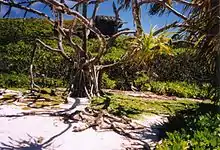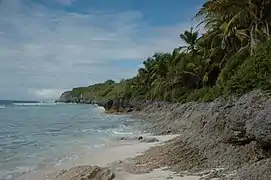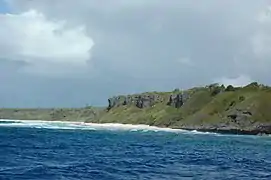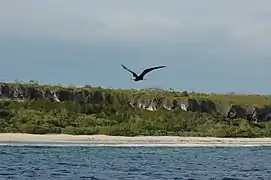| UNESCO World Heritage Site | |
|---|---|
 Map of Henderson Island | |
| Location | Pacific Ocean |
| Criteria | Natural: vii, x |
| Reference | 487 |
| Inscription | 1988 (12th Session) |
| Website | https://whc.unesco.org/en/list/487 |
| Coordinates | 24°22′30″S 128°19′30″W / 24.37500°S 128.32500°W |
 Location of Henderson Island in the Pacific Ocean | |
Henderson Island is an uninhabited island in the south Pacific Ocean. It is part of the Pitcairn Island Group, together with Pitcairn, Oeno, and Ducie Islands. Measuring 9.6 by 5.1 kilometres (6.0 mi × 3.2 mi), it has an area of 37.3 km2 (14.4 sq mi) and is located 193 km (104 nmi) northeast of Pitcairn Island, which is the only inhabited island of the group. It has poor soil and little fresh water, and is unsuitable for agriculture. There are three beaches on the northern end and the remaining coast comprises steep (mostly undercut) cliffs up to 15 m (50 ft) in height. In 1902, it was annexed to the Pitcairn Islands colony, which is now a British Overseas Territory.
Henderson is one of the last two raised coral atolls in the world whose ecosystems remain relatively unaffected by human contact, along with Aldabra in the Indian Ocean. In 1988, it was designated a World Heritage Site by the United Nations. Ten of its 51 flowering plants, all four of its land birds and about a third of the identified insects and gastropods are endemic – a remarkable diversity given the island's size.[1]
History
The island was settled by Polynesians – possibly as early as 800 AD – but by the 1600s it had been abandoned. There is good evidence that the island was continuously occupied for a 600-year period sometime between those dates.[2] The reasons for the inhabitants’ disappearance remain uncertain, but they may relate to an exhaustion of resources[2] and to the disappearance around the same time of the Polynesians on Pitcairn Island, on whom those on Henderson will have relied for many of the basics of life, especially for the stone needed to make tools.[3] The Pitcairn Polynesians may in turn have disappeared because of the decline of nearby Mangareva; thus, Henderson was at the end of a chain of small, dependent colonies of Mangareva.[2] The Polynesians that disappeared may have later migrated further to a bigger island to the east in Easter Island, for it has been noted that the jumping-off points for the early Polynesian colonization of Easter Island originally from Mangareva are more likely to have been from Pitcairn and Henderson, which lie about halfway between Mangareva and Easter.[3] Great similarity between the Rapa Nui language and Early Mangarevan,[3] similarities between a statue found in Pitcairn and some found in Easter Island,[3] resemblance of tool styles in Easter Island to those in Mangareva and Pitcairn,[3] and correspondences of skulls found in Easter Island to two found in Henderson[3] all suggest that Henderson and Pitcairn were early Mangareva stepping-stones to Easter Island,[3] which, in 1999, a voyage with reconstructed traditional Polynesian boats was able to reach from Mangareva after merely a seventeen-and-a-half-day voyage.[3][4]
On 29 January 1606, Portuguese captain Pedro Fernandes de Queirós, leading a Spanish expedition in search of the fabled great south land (Terra Australis), was the first European to see the island, and named it San Juan Bautista.[5] More than 200 years later, on 17 January 1819, Captain Henderson of the British East India Company ship Hercules rediscovered the island. Six weeks later, on 2 March 1819, Captain Henry King, of the Elizabeth, landed on the island to find the king's colours already flying. His crew scratched the name of their ship into a tree, and for a while the island was known as both Elizabeth and Henderson Island. Thomas Raine, master of the ship Surry of London, named it Henderson's Island because it appeared to him, from a conversation he had with James Henderson at Valparaíso, to have been Henderson's discovery.[6]
On 20 November 1820, a sperm whale rammed and sank the Nantucket whaleship Essex (a report of which inspired Herman Melville to write Moby-Dick), and the ship's 20 crewmen arrived at Henderson on 20 December in three small whaleboats. They found the island's only known drinkable water source – a brackish spring on the north shore, exposed at half tide – and ate fish, birds, eggs, crabs and peppergrass, but within a week they had largely exhausted the readily available food. Therefore, on 27 December, the three boats set sail for South America, leaving behind Thomas Chappel, Seth Weeks and William Wright, who chose to stay and survived until their rescue several months later, on 9 April 1821.[7]
In 1902, Henderson Island, along with Oeno and Ducie islands, was formally annexed to the British Empire by Captain G. F. Jones, who visited the islands in a cutter with a crew of Pitcairn Islanders. In August 1937, HMS Leander, on a journey from Europe to New Zealand, carried out an aerial survey of Henderson, Oeno and Ducie, and, on each island, a British flag was planted and an inscription was nailed up proclaiming: "This island belongs to H.B.M. King George VI".[8]

In 1957, a 27-year-old American, Robert Tomarchin, lived the life of a castaway on the island for approximately two months, accompanied by a pet chimpanzee, apparently as a publicity stunt, until people from Pitcairn rescued him in two longboats.[9]
In the early 1980s, the American businessman Arthur "Smiley" Ratliff expressed interest in establishing a mansion for himself on the island, with an airstrip.[10] The Pitcairn Island Council approved his plans but, after environmentalists lobbied to protect the natural ecology and environment of the island, the British Foreign and Commonwealth Office overrode the decision and vetoed the proposed development. Henderson Island was listed as a World Heritage Site in 1988.[1]
In 2019, a group of scientists, journalists, film makers, and artists took part in an expedition to Henderson Island to investigate plastic pollution and marine litter on the island. Five members of the expedition became stranded on the island when their inflatable craft capsized.[11] In 2021, Pitcairn Islanders participated in a scientific expedition to assess the effects of climate change.[12]
In March 2022 a Royal Navy survey by HMS Spey, as part of an effort to update maritime charts regarding British Overseas Territories, found the island to be 1 mile (1.6 kilometres) south of its indicated position. The existing data dates to an aerial survey in 1937, indicating a calculation error when the chart was produced.[13]
Natural resources
Since the introduction of aluminium-hulled long-boats in the 20th century, Pitcairners have made regular trips to Henderson to harvest the wood of miro and tou trees. Usually, they venture to Henderson once per year, but they may make up to three trips if the weather is favourable. Pitcairners carve the wood into curios for tourists, from which they derive much of their income.[14]
Geography

Henderson Island is a raised coral atoll that, with Pitcairn, Ducie and Oeno islands, forms the Pitcairn Island Group. The nearest major landmass is the continent of South America, more than 5,000 km (2,700 nmi) away to the east. This coral limestone island sits atop a conical (presumed volcanic) mound, rising from a depth of roughly 3,500 m (11,500 ft). Its surface is mostly reef-rubble and dissected limestone – an extremely rugged mixture of steep, jagged pinnacles and shallow sinkholes. The island is mostly encircled by steep limestone cliffs up to 15 m (50 ft) high.[15]
There are three main beaches, on the northwest, north, and northeast shores, and the north and northwest beaches are fringed by reefs. The depression at the island's center is thought to be a raised lagoon. There is only one known potable water source, a brackish spring on the north shore exposed at half tide, rising from a crevice in flat rock, large surfaces of which compose the face of the beach. The surrounding ocean tidal range is about one metre at spring tide.[1]
Flora
Apart from five species bordering the beaches, including coconut palms, the vegetation is undisturbed. Henderson Island is covered by 5–10 m tall tangled scrub forest, more thinly covered in the central depression. It has 51 native species of flowering plants, ten of which are endemic to the island. Dominant tree species include coconut palms, Pandanus tectorius, Thespesia populnea (miro), Heliotropium foertherianum, Cordia subcordata (tou), Guettarda speciosa, Pisonia grandis, Geniostoma hendersonense, Nesoluma st-johnianum, Hernandia stokesii, Myrsine hosakae, and Celtis sp.[16]
Fauna

Birds
The island is home to four extant endemic land bird species – the Henderson fruit dove, Henderson lorikeet, Henderson reed warbler and the flightless Henderson crake. Three species of the family Columbidae – the Henderson ground dove, the Henderson imperial pigeon and the Henderson archaic pigeon – as well as the Henderson sandpiper, were formerly endemic to the island, but became extinct around 1000 AD after the arrival of Polynesians. Of the fifteen non-endemic seabird species found, nine or more are believed to breed on the island.[1] Breeding colonies of the globally endangered Henderson petrel formerly existed on Ducie but were wiped out by invasive rats by 1922. It is believed to now nest uniquely on Henderson island.[17]
Bones associated with prehistoric Polynesian settlement sites dating to somewhere between 500 and 800 years ago include those of the Polynesian storm petrel, Marquesan imperial pigeon, and Polynesian or Pacific imperial pigeon which are no longer found on the island, and two others – Christmas shearwater and red-footed booby – that still visit but no longer nest. It is hypothesized that the Polynesian settlers may have driven these bird species, along with six terrestrial snail species, to local extinction, and this loss of a ready and regular food supply may have contributed to the Polynesians' subsequent disappearance.[18][19] The island has been identified by BirdLife International as an Important Bird Area for its endemic landbirds and breeding seabirds.[20]
Other animals
The invertebrate species are largely unknown but a third of the island's known non-marine gastropods and insects are endemic.[1] There are no native mammals but the Pacific rat, introduced by Polynesians 800 years ago, abounds.[21] A skink (Emoia cyanura) and the green sea turtle have been identified, and an unidentified gecko has been reported. There are also crabs.
Biological risk
Land bird populations appear to be relatively stable but there is a high risk of introduction to the island of predators, disease vectors, and diseases by unauthorized landings of yachts. Introduction of the Eurasian black rat or the domestic cat would be likely to cause almost immediate extinction of the ground-dwelling Henderson crake and possibly other species. The endemic birds may have no immunity to the fatal avian pox which is transmitted by biting flies such as Hippoboscidae.[16]
Between July and November 2011 a partnership of the Pitcairn Islands Government and the Royal Society for the Protection of Birds implemented a poison baiting programme aimed at eradicating the Pacific rat.[22] Mortality was massive but of the 50,000 to 100,000 population, 60 to 80 individuals survived and the population has now fully recovered.[23]
Plastic debris
Research published in April 2017[24] looked at debris on several beaches, and reported "the highest density of plastic rubbish anywhere in the world" as a result of the South Pacific Gyre. The beaches contain an estimated 37.7 million items of debris together weighing 17.6 tonnes. In a study transect on North Beach, each day 17 to 268 new items washed up on a 10-meter section. The study noted that purple hermit crabs (Coenobita spinosus) make their homes in plastic containers washed up on beaches, and the debris may reduce shoreline gastropod diversity, may contribute to a reduction in the number of sea turtle laying attempts and may increase the risk of entanglement for coastal-nesting seabirds.[25][26][27]
In June 2019, an expedition organised by the UK Government attempted to remove some of the plastic debris from the island's East beach. The team collected six tonnes of rubbish, but weather conditions hampered efforts to take the rubbish off the island.[28][29] A followup expedition in July 2022 collected further plastic.[30]
Gallery
 East beach
East beach Northwest beach
Northwest beach Northwest beach
Northwest beach North beach
North beach North beach
North beach
References
- 1 2 3 4 5 "UNESCO World Heritage listing". Archived from the original on 2 August 2020. Retrieved 21 May 2011.
- 1 2 3 Weisler, Marshall I. (1995). "Henderson Island prehistory: colonization and extinction on a remote Polynesian island". Biological Journal of the Linnean Society. 56 (1–2): 377–404. doi:10.1111/j.1095-8312.1995.tb01099.x.
- 1 2 3 4 5 6 7 8 Diamond, Jared (2005). Collapse: How Societies Choose to Fail or Succeed. Penguin Group. ISBN 0-670-03337-5.
- ↑ "The Voyage to Rapa Nui 1999–2000". Polynesian Voyaging Society. Archived from the original on 12 November 2010.
- ↑ Brand, Donald D. (1967). The Pacific Basin: A History of its Geographical Explorations. New York: The American Geographical Society. p. 136.
- ↑ Dehner, Steve (2020). The Armchair Navigator I. Archived from the original on 1 September 2021. Retrieved 26 April 2021.
- ↑ Heffernan, Thomas Farel (1990). Stove by a Whale: Owen Chase and the Essex. Wesleyan University Press. pp. 62–84. ISBN 978-0-8195-6244-9. Archived from the original on 16 July 2020. Retrieved 25 July 2013.
- ↑ Rehder HA; Randall JE (15 January 1975). "Ducie Atoll: Its history, physiography and biota" (PDF). Atoll Research Bulletin. 183: 1–55. doi:10.5479/si.00775630.183.1. Archived (PDF) from the original on 18 May 2014. Retrieved 6 June 2013.
- ↑ Winthrop, Mark. "The Henderson Island monkey story". Archived from the original on 16 October 2011. Retrieved 21 May 2011.
- ↑ Serpell J (1983). "Desert island risk". New Scientist. No. 5 May 1983. p. 320. Archived from the original on 1 September 2021. Retrieved 14 September 2020.
- ↑ Vance/McGregor, Andrea/Iain (25 July 2019). "Desert Island Dump". Stuff. Archived from the original on 26 July 2019. Retrieved 25 July 2019.
- ↑ Vance, Andrea (29 August 2021). "Pitcairn Islanders refuse to let Covid-19 halt vital climate change research". Stuff. Archived from the original on 29 August 2021. Retrieved 29 August 2021.
- ↑ Mehta, Amar (11 March 2022). "Royal Navy finds uninhabited Henderson Island has been marked on charts in the wrong place for 85 years". Sky News. Archived from the original on 11 March 2022.
- ↑ Brooke, M. de L.; Hepburn, I.; Trevelyan, R. J. (2004). "Henderson Island World Heritage Site Management Plan 2004–2009" (PDF). London: Foreign and Commonwealth Office. p. 19. Archived from the original (PDF) on 19 July 2007. Retrieved 31 March 2009.
- ↑ "Henderson Island". Travellers Point. Retrieved 12 August 2023.
- 1 2 Graves GR (1992). "The endemic land birds of Henderson Island, Southeastern Polynesia: Notes on natural history and conservation" (PDF). The Wilson Journal of Ornithology. 104 (1): 32–43. JSTOR 4163114. Archived (PDF) from the original on 4 July 2020. Retrieved 29 January 2018.
- ↑ "Potential for rat predation to cause decline of the globally threatened Henderson petrel Pterodroma atrata: evidence from the field, stable isotopes and population modelling" (PDF). 10 March 2010. Archived (PDF) from the original on 4 March 2016. Retrieved 16 May 2017.
- ↑ Steadman DW, Olson SL (1 September 1985). "Bird remains from an archaeological site on Henderson Island, South Pacific: Man-caused extinctions on an "uninhabited" island". PNAS. 82 (18): 6191–6195. Bibcode:1985PNAS...82.6191S. doi:10.1073/pnas.82.18.6191. PMC 391018. PMID 16593606. Archived from the original on 24 September 2015. Retrieved 13 November 2011.
- ↑ Weisler, Marshall I. (Spring 1994). "The Settlement of Marginal Polynesia: New Evidence from Henderson Island". Journal of Field Archaeology. 21 (1): 83–102. doi:10.1179/jfa.1994.21.1.83. JSTOR 530246.
- ↑ BirdLife International. (2012). Important Bird Areas factsheet: Henderson Island. Downloaded from http://www.birdlife.org Archived 10 July 2007 at the Wayback Machine on 21 January 2012.
- ↑ RSPB (20 December 2011). "Aircraft carrier and helicopters come to unique island's rescue". BirdLife. Archived from the original on 19 July 2013. Retrieved 16 May 2017.
- ↑ Royal Society for the Protection of Birds. "Henderson Island Restoration Project". Archived from the original on 19 January 2012. Retrieved 28 May 2012.
- ↑ Amos, W.; Nichols, H.J.; Churchyard, T.; Brooke, M. de L. (20 April 2016). "Rat eradication comes within a whisker! A case study of a failed project from the South Pacific". Royal Society Open Science. 3 (4): 160110. Bibcode:2016RSOS....360110A. doi:10.1098/rsos.160110. PMC 4852649. PMID 27152226.
- ↑ Lavers, Jennifer L.; Bond, Alexander L. (2017). "Exceptional and rapid accumulation of anthropogenic debris on one of the world's most remote and pristine islands". PNAS. 114 (23): 6052–6055. Bibcode:2017PNAS..114.6052L. doi:10.1073/pnas.1619818114. PMC 5468685. PMID 28507128.
- ↑ Remote South Pacific island has highest levels of plastic rubbish in the world Archived 12 November 2020 at the Wayback Machine, Dani Cooper, ABC News Online, 16 May 2017
- ↑ Hunt, Elle (15 May 2017). "38 million pieces of plastic waste found on uninhabited South Pacific island". The Guardian. Archived from the original on 15 May 2017. Retrieved 16 May 2017.
- ↑ "No one lives on this remote Pacific island – but it's covered in 38 million pieces of our trash". Washington Post. Archived from the original on 16 May 2017. Retrieved 16 May 2017.
- ↑ Vance/McGregor. "Desert Island Dump: Chapter 2". Stuff. Archived from the original on 27 July 2019. Retrieved 26 July 2019.
- ↑ Vance/McGregor (16 December 2019). "Plastic rubbish could finally be removed from world's most polluted place". Stuff. Archived from the original on 17 December 2019. Retrieved 17 August 2020.
- ↑ Andrea Vance (17 July 2022). "Upsetting scenes as trash returns to previously cleared paradise, Henderson Island". Stuff. Retrieved 12 August 2023.
Further reading
- Jared Diamond (2005), Collapse: How Societies Choose to Fail or Succeed, ch. 3.
- Nathaniel Philbrick (2001), In the Heart of the Sea: The Tragedy of the Whaleship Essex, Penguin Books 2001.
- Chase, Owen (1821). Narrative of the Most Extraordinary and Distressing Shipwreck of the Whale-Ship Essex. W. B. Gilley. No ISBN. New York.
- Nickerson, Thomas (1984). The Loss of the Ship "Essex" Sunk by a Whale and the Ordeal of the Crew in Open Boats. Nantucket Historical Society.
- Kelly, Celsus (1966), La Austrialia del Espíritu Santo: the journal of Fray Martin de Munilla, O.F.M., and other documents relating to the voyage of Pedro Fernández de Quirós to the South Sea (1605-1606) and the Franciscan Missionary Plan (1617-1627), Cambridge, published by the Hakluyt Society at Cambridge University Press, (Works issued by the Hakluyt Society, 2nd ser., no. 126–127).



